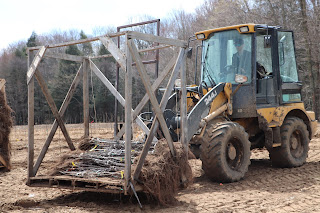We live on a fruit farm. The official name of the farm/business is Martin's Family Fruit Farm. We grow and pack apples. Our house and yard are surrounded by many apple trees as well as orchard equipment and buildings. The above photo is my view from our back deck in springtime. I love watching the orchard scenes change with the coming and going of different seasons.
Ken does most of his work as a fruit farmer in several orchards that Martin's owns but are not in our local vicinity. Those orchards are in Vienna, Ontario, near Port Burwell on the shores of Lake Erie, so Ken drives an hour and a quarter to work every weekday. He supervises our crews of offshore workers in their various responsibilities that come with maintaining apple orchards throughout an entire growing season.
Once in awhile, I ride along with Ken when he goes to Vienna. I'm intrigued with the orchard goings-on, and it seems like every time I observe the orchard scene, I learn something new about growing apples. I've gone with Ken to Vienna twice this year so far, both times on a Saturday in the spring. On both trips, I took my camera with me and tried to capture in photos some of the workings of our orchards.
I plan to publish a little series of blog posts about what I've seen and learned on Orchard Days throughout the apple season this year. The pictures I include will be from both the Vienna farms and the orchards in the area where we live. This first post in the series is about planting apple trees - one of the earliest jobs to do in the spring on an apple farm.
Fruit farmers don't do new plantings every year, but when they do, they need to prepare the field or acreage for the new trees. This preparation often begins with removing the old trees that are well beyond producing their best crops. Apple trees age and decline in production until it is no longer wise and efficient to keep harvesting their fruit. I always feel a twinge of sadness when I see piles of dead trees in an orchard. I know that the old needs to be uprooted so that the new has opportunity to take root, but that knowledge doesn't entirely remove my lament. The bare orchard often lies fallow for at least a year before the new planting. Perhaps it has its own season of silent grief before picking up and moving on to new and beautiful growth.
Martin's buys the majority of their young apple trees from a nursery. The individual trees are in their second year of existence by the time they come to the field for planting. The young apple saplings appear to be individual branches simply stuck in the ground at intervals. These thin, leafless "twigs" are called whips, because that is exactly what they look like.
The whips with roots usually come in bundles of ten. A skid loader brings the rack of bundles to the field where the trees can easily be loaded on to the tree planter pulled behind a tractor.
Workers need to cut the ties that bind the bundles, for easier access to the tree whips for planting.
Here a crew of around twenty workers perform the planting operation. A GPS guides the tractor and planter over the field, marking the rows with precision.
Four men work on the two-row planter. One man in each pair stands on the planter and hands the whips to the one seated who feeds the young trees into the planting mechanism.
The planter sets the whips into a groove in the soil; I guess one could say it plants the trees after a slanting fashion. Each sapling need to be situated into an upright position and the soil needs to be tamped firmly around its thin trunk.
This "uprighting" and tamping is done by hand (and foot) as the planting crew members traipse along behind the tractor and planter. Shovels and boots are tools that assist.
After Ken finished coaching the workers in the field that day, we drove to Martins' large apple storage facility. I saw the rows and rows of empty bins stacked there, and thought about what all needs to happen in the orchards during the months (and years!) between planting trees and filling those bins at harvest time. My appreciation goes to all the workers who will make it possible.
There's nothing quite like a crisp Ambrosia apple for a snack. I surely am grateful that somebody once planted some apple trees!
Note: Ken is the apple expert around here. I will definitely be asking him to look over these blog posts for accuracy before I publish them! You may get a taste of his knowledge and expertise in orchard management by listening to him speak on Everyday Expertise, a podcast our son Rolin recently created.





























